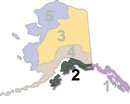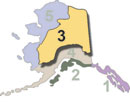The brown bear has statewide distribution in Alaska. As far as trophy hunters are concerned, brown bears and grizzlies are two different animals, and this distinction is carried forward in both the Boone & Crockett and the Safari Club International records books. Each bear has different scoring standards, and both organizations draw lines on the map of Alaska to delineate the geographical boundaries of what they consider a brown bear or a grizzly. The Alaska Department of Fish and Game (ADF&G) makes no such distinction, and both bears are treated the same for regulatory purposes. Most hunters recognize a bear that has access to salmon as a brown bear. This includes bears found in most coastal areas, or along most of the major river systems in the state. Grizzlies are generally thought to be bears found in some parts of the Interior and in the Arctic.
The brown bear has statewide distribution in Alaska. As far as trophy hunters are concerned, brown bears and grizzlies are two different animals, and this distinction is carried forward in both the Boone & Crockett and the Safari Club International records books. Each bear has different scoring standards, and both organizations draw lines on the map of Alaska to delineate the geographical boundaries of what they consider a brown bear or a grizzly. The Alaska Department of Fish and Game (ADF&G) makes no such distinction, and both bears are treated the same for regulatory purposes. Most hunters recognize a bear that has access to salmon as a brown bear. This includes bears found in most coastal areas, or along most of the major river systems in the state. Grizzlies are generally thought to be bears found in some parts of the Interior and in the Arctic.
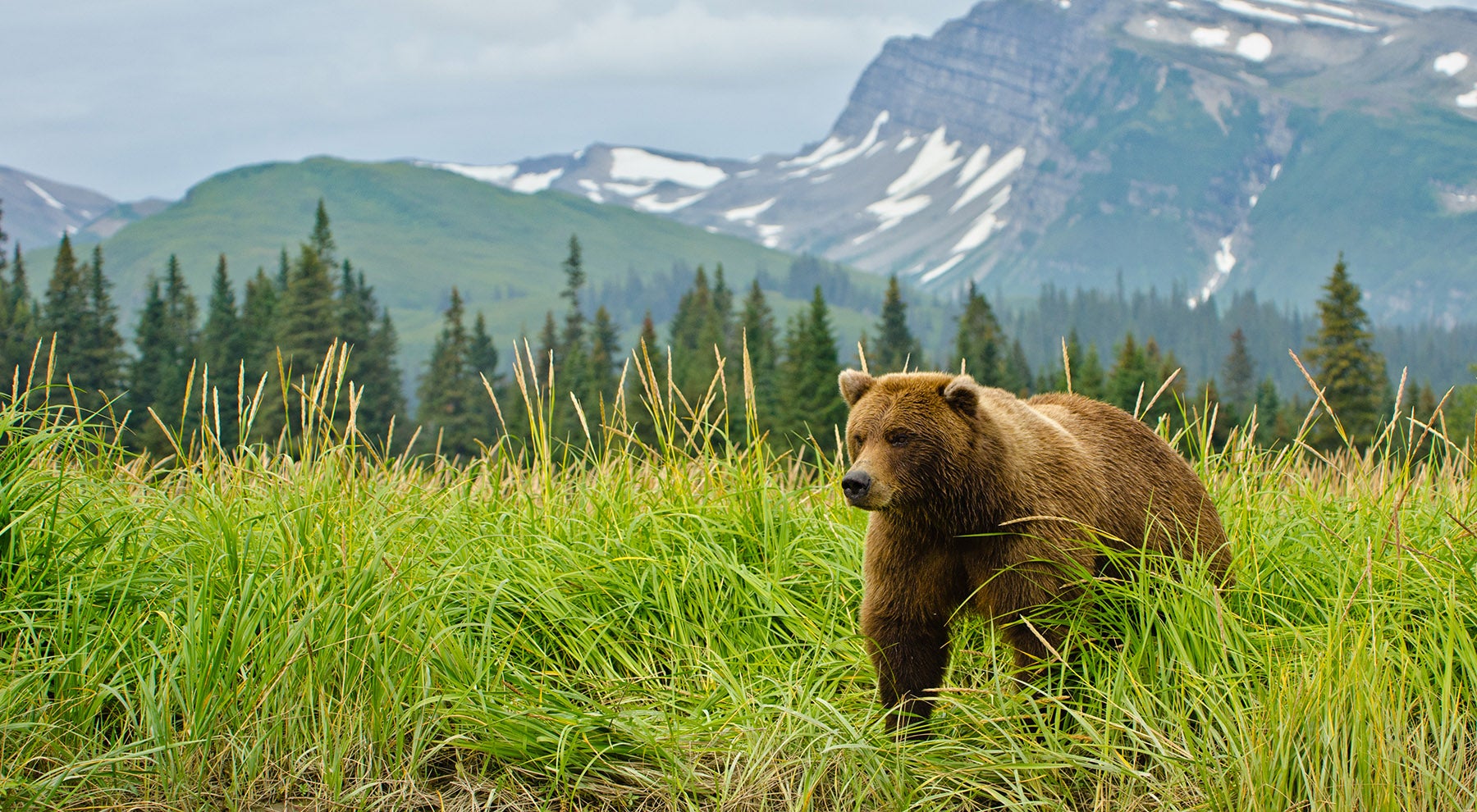
Brown / grizzly bears vary in color from dark chocolate brown to blond. Some regional color variations occur and are highly prized, such as the so-called "Toklat" coloration; dark legs, dark face, and lighter-colored body hair. A "silvertip" is a bear with darker underfur and bleached-out guard hairs that turn nearly white at the tips. Most brown/grizzly bear hunters are concerned primarily with the trophy value of the animal, however, some do eat the meat as well, particularly meat from bears that have been dining on vegetation for some time. Meat from bears that are dining on carrion or fresh meat can be unpalatable. With the exception of some subsistence hunts, hunters are not required to salvage the meat of brown/grizzly bears. Shooting sows is not prohibited, but it is generally discouraged; ADF&G has produced a DVD instructing hunters on how to tell the difference between male and female bears.
Seasons
Brown / grizzly bears are hunted in both the spring and the fall. Spring hunts typically occur in April and May. Bear hunting typically resumes in earnest in September and October and lasts until the bears den up in the latter part of October.
Regions & Methods

(map courtesy ADF&G)
Brown / grizzly bears are distributed statewide. Bear density per square mile is highly variable, with the lowest density occurring in the Arctic, and the highest densities occurring on the Alaska Peninsula, Kodiak Island, and the ABC islands in the Southeast. Generally, densities are influenced by the availability of food in an area, with salmon providing an incentive for larger numbers of bears crowding some streams.
Region 1 (Southeast Panhandle)
Game Management Units: GMU 1, 2, 3, 4 & 5
Region 1 South: Southeast Panhandle | Region 1 North: Yakutat / Cordova Area
Available species:
Black Bear | Brown / Grizzly Bear | Deer | Elk | Goat | Moose | Wolf
Southeast Alaska has a healthy brown bear population, however, the thick vegetation in this area makes spotting one from a distance a real challenge. Focus your efforts on tidal flats, shoreline areas, and large openings above the treeline. Spring bears find themselves on the tide flats and coastlines, feeding on emergent vegetation, kelp, or other edible plant or animal life that washes up with the tides. Look for tide flats that have clam beds. Bears can sometimes be spotted and approached from a distance while they are distracted digging clams at low tide. Try to plan your spring hunt to coincide with minus tides to maximize your opportunities. A popular technique is to cruise the shoreline areas and glass from the boat. Once a bear is located, it is examined from a distance for its trophy value before a stalk is made. In the fall, focus on salmon streams or glass clear-cut areas or other openings above the treeline for bears feeding in berry patches. Owing to the close vegetation found along salmon streams, extreme caution is urged. Perhaps the most well-known area to hunt brown bears in Southeast is the ABC Islands (Admiralty, Baranof, and Chicagof), however many other islands also produce brown bears, along with the mainland.
Region 2 (North Gulf Coast, Kenai Peninsula, Kodiak / Afognak Archipelago)
Game Management Units: GMU 6, 7, 8, 14C, 15
Region 2 East: North Gulf Coast / Kenai Peninsula | Region 2 West: Kodiak / Afognak Archipelago
Available species:
Bison | Black Bear | Brown / Grizzly Bear | Caribou | Dall Sheep | Deer | Elk | Goat | Moose | Wolf
Brown bears are found throughout the Kenai Peninsula, however, spring bears are widely-scattered because denning sites exist all the way from the mountains out onto the Kenai flats.
Region 3 (Interior, central & eastern Brooks Range)
Game Management Units: GMU 12, 19, 20, 21, 24, 25, 26B, 26C
Region 3 East: Eastern Arctic / Eastern Interior | Region 3 West: Central Interior
Available species:
Bison | Black Bear | Brown / Grizzly Bear | Caribou | Dall Sheep | Moose | Wolf
The eastern Arctic has a healthy grizzly population and it's not uncommon to run into one while you're hunting moose or caribou up that way. The central Interior sports good numbers as well, and some of these bears will be a bit larger than the Arctic grizzlies, due to good access to salmon in some river systems.
Region 4 (Southcentral, Alaska Peninsula, Aleutians)
Game Management Units: GMU 9, 10, 11, 13, 14A, 14B, 16, 17
Region 4 East: Southern Interior, Anchorage, Susitna Valley | Region 4 West: Bristol Bay and the Alaska Peninsula
Available species:
Bison | Black Bear | Brown / Grizzly Bear | Caribou | Dall Sheep | Goat | Moose | Wolf
Southcentral Alaska has a stable and healthy brown bear population and as you go west, it gets even better. Katmai National Park, out toward the Alaska Peninsula, is a very popular bear viewing area and is of course off-limits to hunters. But there are many places to hunt brown bears in this area.
Region 5 (Western Brooks Range, west coast to Bristol Bay)
Game Management Units: GMU 18, 22, 23, 26A
Region 5 North: Western Arctic | Region 5 South: Yukon / Kuskokwim Delta
Available species:
Black Bear | Brown / Grizzly Bear | Caribou | Dall Sheep | Moose | Muskox | Wolf
Region 5 contains many square miles of open tundra, much of which produces berries by the fall hunting season. Bears are attracted to these areas, and if you can find an elevated perch from which to glass, opportunities can be very good at times. Alternatively, you can consider glassing your moose or caribou kill site(s) for black bears three or four days after you have finished packing meat.
Hunting Tactics
There are several ways brown/grizzly bears are hunted in Alaska. Regardless of the methods used, timing is everything. Whereas moose may be taken fairly consistently in mid-morning, bears are early risers or, in some cases, totally nocturnal. If you linger over breakfast, your chances of seeing larger bears could drop significantly. Let's look at some methods of hunting brown/grizzly bears in Alaska.
Baiting
With limited exceptions mostly restricted to predator control situations, the baiting of brown bears is illegal in Alaska.
Still Hunting
Salmon are a primary food source for brown bears during the summer and fall months. And because salmon are found in streams that are often choked with thick vegetation along the banks, one of the best ways of encountering them is to sit on a stand or stalk very quietly along the banks. Sneaking along a salmon stream, hoping to encounter a brown bear at close range is about as close to the polar opposite safe behavior you are supposed to follow in bear country, but sometimes it's the only way you will see one.
Spot and Stalk
The primary method of hunting brown/grizzly bears is spot and stalk, and it can be accomplished in open country, above riparian zones along salmon streams, or from mountainsides and even valleys. The most important component of good spot and stalk hunting is the location of your stand. Choose a glassing position that allows a good view of prime habitat. Habitat quality is mostly determined by available food sources. Are blueberry patches nearby? Is there a kill nearby? Does a salmon stream flow through the area? These things will attract bears. Choose a location that overlooks these places. Next, ensure that your position allows the prevailing winds to carry your scent away from the area you are glassing. To determine wind direction, first look for cloud movement overhead. Then factor in the configuration of the terrain. Wind flows through an area the same way water moves through a stream bed; it flows over and around hillocks, cut banks, and tall vegetation, forming back-eddies and swirls as it moves. For the most part, you want to position yourself anywhere from directly downwind to about 40 degrees downwind of the area you're glassing. You can get by with positioning yourself directly cross-wind from the target area, but you may have a lot fewer options when it comes to making a stalk. You'll probably have to hook downwind and then make your way into the wind to make your stalk.
Is it a Brown Bear or a Grizzly?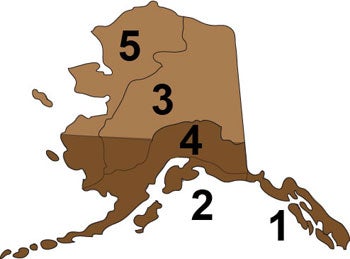
The Alaska Department of Fish and Game recognizes two subspecies of brown bears in Alaska; brown bears of the Kodiak / Afognak Archipelago (ursus arctos middendorffi) and brown bears found elsewhere in Alaska (ursus arctos horribilis). The Kodiak bears are thought to have a genetic connection with bears found in Russia and are genetically distinct from other brown bears in Alaska. The greatest distinction of the Kodiak bears as far as trophy hunters are concerned is skull size, with Kodiak bears edging out the Alaska Peninsula bears by a small margin (generally Kodiak bears have wider skulls, and the Peninsula bears are slightly longer).
Generally speaking, hunters recognize that a brown bear is any bear that potentially has access to salmon. That's why the Boone and Crockett Club's original guidelines indicated that any bear taken within 50 miles of the Alaska coastline was a brown bear. More recently, in recognition of the many brown bears that are found far inland, the map was redrawn. Lines on a map are somewhat arbitrary though, and brown bears are certainly found in "grizzly country" and vice-versa.
For scoring purposes, the Boone and Crockett Club requires that bears taken in the following areas be scored as brown bears: GMUs 1-17, and portions of GMUs 18 & 19 lying south of the 62nd parallel. Bears taken outside this area are scored as grizzlies.
From the standpoint of the Alaska hunting regulations, the Alaska Department of Fish and Game considers all brown bears and grizzlies found in Alaska to be the same animal.
Is it a Boar or a Sow?
Though the Alaska hunting regulations permit the taking of boars and sows (the taking of sows with cubs is generally prohibited), the intent of ADF&G and of most hunters is to take mature males. The reason both are allowed is to accommodate hunters who cannot easily tell the difference in field conditions. That said, learning how to tell boars from sows is a skill worth honing. Here are a few pointers.
As a rule, mature boars are larger than sows, sometimes as much as twice the size of a sow the same age. Because the breeding season is in the spring, if you see two bears together and one is obviously pursuing the other, chances are the bear chasing the other is a boar. Another good indicator is the shape of the head. Boars have wider and blockier heads than sows, and sows appear to have longer snouts and narrower heads. Skull configuration is a lot like looking at the heads of dogs, so if you can tell a male hunting dog from a female by the shape of the head, you're well on your way to learning how to tell a boar from a sow.
Assessing Brown / Grizzly Bear Trophy Value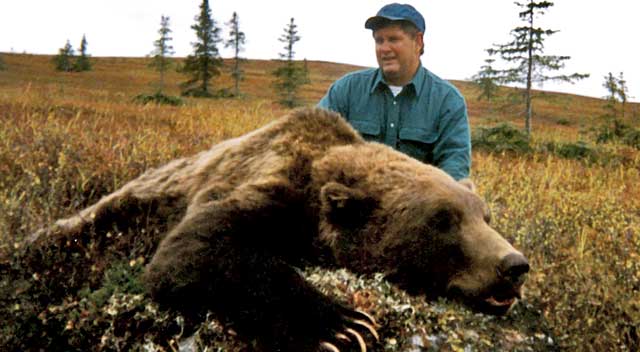
Judging any bear in field conditions is a skill that can only be acquired from experience. That said, certain principles are generally accepted when it comes to determining the trophy value of a bear. Because the most common hunting technique for hunting brown/grizzly bears is spot and stalk, it's likely that your first opportunity to judge a bear in the field will be by direct observation of a particular animal.
General Appearance and Behavior
Though there are notable exceptions, look for bears that don't show a lot of daylight between the belly and the ground; as bears age, they gain weight. Lean, lanky-looking bears are probably younger animals. There are exceptions with some very large bears, but those bears have noticeably longer bodies in proportion to their heads. Larger bears also appear to have longer necks.
In some areas, larger bears are nocturnal, or nearly so. This means that your chances of spotting a bigger male are better in the early morning or late evening.
Gait and Movement
The bear's gait is sometimes a clue to its size. Smaller bears tend toward faster, jerky movements and other behaviors that suggest a lack of confidence. Larger bears sometimes eat smaller bears, so their nervousness is understandable. Bears that exhibit slower, ponderous movements might demand a closer look.
Look the bear over carefully from all sides, if possible. Whether it is a spring or a fall bear, the hide can be rubbed clear down to the skin, rendering the hide worthless as a trophy. Pass on such bears, and hold out for something with more hair.
Track Size
Another indicator of a bear's size is the width of its track. Measure the width of the front pad imprint and you can rough-guess the squared size of the animal. Generally, the width of the front pad is measured and two inches are added to calculate the squared size. For example, a pad width of six inches would be an eight-foot bear, a width of seven inches would be a nine-footer and a width of eight inches would be a ten-foot bear.
As brown/grizzly bears mature, their claw color often fades from brown to nearly white. Old bears often have white claws.
How to Measure a Brown Bear Trophy
With the exception of subsistence hunters, most hunters give some thought to the size of an animal before they harvest it. Whether such considerations are based on the conservation ethic of wanting to take mature animals that are in their waning reproductive years, or simply trophy-collecting standards, the preference is generally to take larger animals. Some years ago the Boone and Crockett Club was established as a way to recognize animals of unusual size.
If you plan to have your bear officially scored for records-book purposes, the only qualifying measurement used by the Boone and Crockett Club is the size of the skull. The measurements are simple; use a caliper to measure the overall length of the skull, and measure the width at the widest point (the zygomatic arch). Measurements are made to the nearest 1/16 of an inch. Add these two numbers together for the final score.
the skull. The measurements are simple; use a caliper to measure the overall length of the skull, and measure the width at the widest point (the zygomatic arch). Measurements are made to the nearest 1/16 of an inch. Add these two numbers together for the final score.
Note that to be officially scored in the Boone and Crockett records, the skull must be dried for 60 days after the animal was killed, and must be scored by an official measurer with the club.
A grizzly skull must score a minimum of 23 inches to make the Boone and Crockett records, and a brown bear must measure at least 26 inches.
Hide Measurements
As an indicator of the true size of the animal, most hunters are interested in the size of the wrapper the bear came in. This is derived by measuring the flat, unstretched hide. Measure the length from the tip of the nose to the tip of the tail, then measure the width from the end of the claws, across the front legs. Add these two numbers together and divide by two. The resulting figure is the "square" measurement of the hide. This is the number heard most often around bear camp; the "squared" measurement of the bear.
Take your measurements after fleshing, but before salting in order to determine the actual size of the hide. Fat and muscle tissue left attached to the hide prevent it from laying completely flat and give you a smaller measurement than a properly fleshed hide.
Some guide services have been known to fudge the numbers by stretching the hide before measurement. This embarrassing tactic does little to determine the actual size of the animal, however, it does serve to inflate the ego of the shooter and the reputation of the guide service beyond their natural proportions.
Additional Resources on Brown Bear Hunting
Here is a list of additional resources on brown bear biology, hunting tactics, meat, and trophy care, and protecting yourself from problem bears.
Brown Bear Biology
- Alaska's Mammals, by Dave Smith
- Animal Tracks Alaska, by Sheldon & Hartson
- The Nature of Alaska, by James Kavanaugh
- Wild Mammals of North America, Feldhammer, Thompson, and Chapman
Brown Bear Hunting
- Ask the Grizzly / Brown Bear Guides, by J. Y. Jones
- Bear Hunting in Alaska, by Tony Russ
- Big Game in Alaska, by Morgan Sherwood
- Float Hunting Alaska's Wild Rivers, by Michael Strahan
- Fury in the Alders (DVD), by Billy Molls
- Hunting Alaska's Coastal Giants (DVD) by Glacier Guides, Inc.
- Hunting in Alaska, by Chris Batin
- Kodiak Island and its Bears, by Harry B. Dodge III
Bear Stories
- Alaska Bear Tales, by Larry Kaniut
- Alaska More Bear Tales, by Larry Kaniut
- Last of the Great Brown Bear Men, by Marvin Clark
- The Grizzly Maze, by Nick Jans
- Track of the Kodiak, by Marvin Clark
Meat and Trophy Care
- Alaska Field Care Manual Vol. 1, by Michael Strahan
- Alaska Field Care Manual Vol. 2, by Michael Strahan
Protecting Yourself from Problem Bears
- Alaska Magnum Bear Safety Manual, by Stephen Stringham
- Backcountry Bear Basics, by Dave Smith
- Bear Attacks, by Stephen Herrero
- Bear Attacks of the Century, by Larry Mueller and Marguerite Reis
- Bear vs Man, by Brad Garfield
- Fighting for Your Life, by Tom Hron
- Outwitting Bears, by Gary Brown


